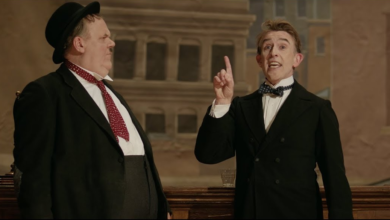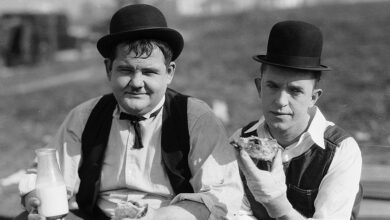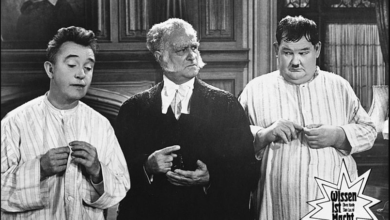The Laurel-Hardy laughter legacy: 95 years young, and still going strong
The Second 100 Years, released on 8 October 1927, formally billed Stan Laurel and Oliver Hardy as a comic pair for the first time.

Close to a century ago, Metro-Goldwyn-Mayer turned October 8 into an event movie date for comedy lovers. On this day in 1927, the studio released the silent film, The Second 100 Years, which formally billed Stan Laurel and Oliver Hardy as a comic pair on the Hollywood screen for the first time. Laurel and Hardy had appeared in the same films around 10 times before this, but the Hal Roach production is acknowledged as the first release where the pair would officially be cast together as lead stars of the show.
The hit team of Laurel-Hardy that was born in The Second 100 Years would go on to regale as comic phenomena for almost two and a half decades till the early 1950s. Not only did the 1927 release establish their chemistry as undoubtedly the greatest ever comic duo in Hollywood, it also set several ground rules on how comedy — specifically, slapstick — would play out on screen. The importance of the film is ironic because although it set the template for a brand of entertainment that would influence generations of artistes to come, Laurel and Hardy as entertainers are perhaps not as spontaneously remembered by the audience of today.
For, it is probably easier for many Gen Now comedy fans to recognise Laurel and Hardy as the two funny men hanging in a black-and-white photo frame in Joey and Chandler’s living room in Friends than name any one of the hit films the duo made. Those who’ve watched the marvellous 2018 biographical dramedy, Stan & Ollie, starring Steve Coogan as Laurel and John C. Reilly as Hardy, would also know them as aging comedians out give a push to their careers through a hectic stage tour in post-war England. Laurel and Hardy don’t draw the automatic recall of, say Charlie Chaplin, among Gen Z viewers perhaps because most of their films are not freely available on video or streaming platforms. Also, though their antics have survived as formula in modern-day slapstick, Laurel and Hardy unlike Chaplin never seemed interested in exploring a deeper socio-political context through their comedy. The genre meanwhile became more complex in the themes it explored
The Second 100 Years remains an interesting study as to why and how the legacy of the duo has survived time despite the changing face of cinematic humour and its intents. By 1927, it was deemed profitable for MGM to build a brand around the two comedians as a duo, given the odd couple image they managed to create. For the Fred Guiol directorial, screenwriter Leo McCarey wrote a story that filled a runtime of just over 20 minutes, aimed at packing in all that defined the duo’s fun factor — from comic timing to physical humour to pantomime to sharp wit (those were the early days of the moving pictures and people actually lined up to pay and watch films that ran for less than half an hour, often clubbed together with a bigger feature or other short features).
The plot backdrop of The Second 100 Years is typically simplistic: Title cards introduce Laurel as Little Goofy and Hardy as Big Goofy, cellmates who are in for life. The jail governor and warden are preparing for the visit of some high profile French police officers, due to arrive to study prison management ideas. Meanwhile Big Goofy and Little Goofy plan to finish digging their tunnel for escape the same night.
The misadventure that fills the film’s runtime highlights Laurel-Hardy’s signature knack at using chaos to create a mix of unapologetic slapstick and occasional wit. The concoction would seem commonplace today. Over the years several funny acts from Peter Sellers to Rowan Atkinson to Jim Carrey, and from The Simpsons to The Flintstones to Tom & Jerry among many others have revealed influence of the formula. Back in their days, when cinema wasstill exploring ways to craft a language removed from the stage, the simplistic yet winning formula of The Second 100 Years was relatable enough to be carried forward in more significant Laurel-Hardy hits as Big Business (1929), The Music Box (1932), County Hospital (1932),Sons Of The Desert (1933), Babes In Toyland (1934), Way Out West (1937) and The Flying Deuces (1939).The 1927 release was exceptional also for the way it cemented the Laurel-Hardy comic timing, sparks of which had been seen in films such as Duck Soup and With Love And Hisses, both released earlier the same year before the duo was officially announced as a team.
Laurel and Hardy’s success as performing artistes is perhaps best underlined by the ease with which they morphed from stars of the silent era to equally successful entertainers once talkies became the trend. All the films they made after 1929 were talkies and the duo worked as a team till 1951 when they released their final film, Atoll K (released as Robinson Crusoel and in the UK, besides as Utopia in the US the year before). Their trademark slapstick in later films as Atoll K was often critically panned for being predictably silly, although the brand of humour somehow continued surviving in feature films, animated films and sitcoms.
Before The Second 100 Years, when Laurel and Hardy appeared in the same film for the first time, the former was already a star. The year was 1921 and the film, The Lucky Dog, where they appeared as two individual actors. Laurel played the lead while Hardy essayed a supporting role. By 1927 when they were formally cast as a comic duo, Hardy’s contrasting personality as a funnyman to Laurel’s instantly worked wonders to create their odd-couple chemistry. Filmmakers the world over would realise the presence of a chubby protagonist alongside a diminutive lead never fails to trigger the laughs, and the idea continues to be commonplace in films, sitcoms and animation features to this day.
Over the years, the buffs have often noted several such set-pieces in various comedy shows and films. Hardy’s bossy mannerism towards the less imposing Laurel, for instance, bears likeness to Fred Flintstone’s similar attitude towards his buddy Barney Rubble in The Flintstones. Incidentally, Hardy’s overbearing attitude and Laurel’s subsequent emerging as a cry-baby of sorts, which became their trademark, was actually missing from The Second 100 Years. Rather, in the film Hardy’s Big Goofy is a kind soul who doesn’t mind breaking a cigarette into two to share it with his cellmate Little Goofy. In comparison, Laurel’s Little Goofy is far more sly in this film than the image he would eventually settle for in his career. You could call it an early experimentation with image. Or, a detour to arriving at the right formula. After all, as Big Goofy tells Little Goofy in The Second 100 Years, a detour is “the wrong way to the right place”.





